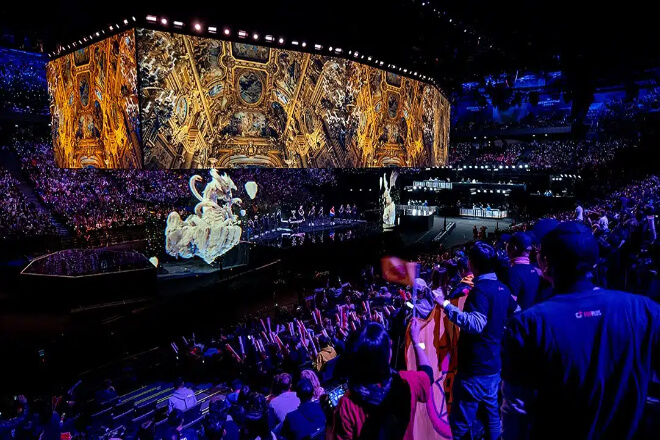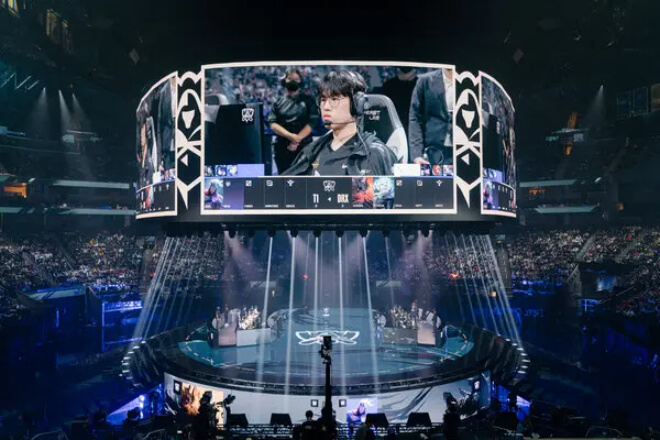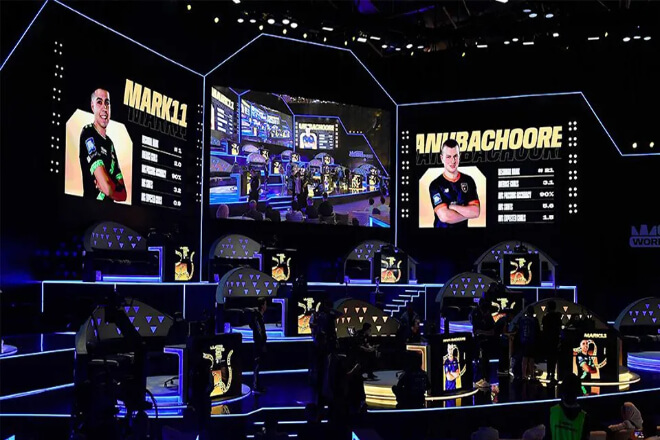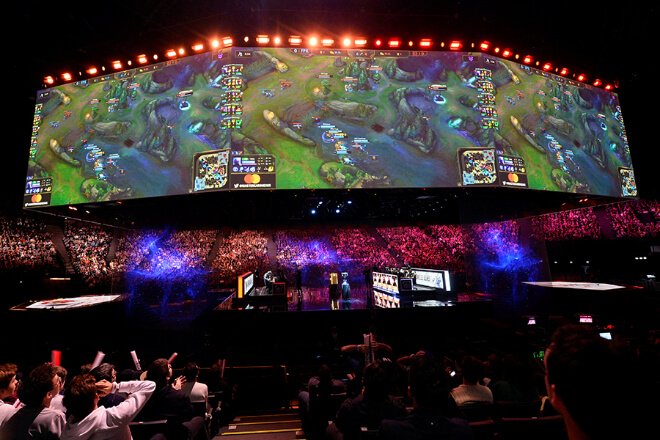Introducción
In the world of e-sports, every frame of the picture may determine the outcome.
Players compete fiercely on the virtual battlefield, and the emotions of the audience fluctuate with the pictures on the screen.
So, what are the requirements for the refresh rate of pantallas de visualización LED in e-sports clubs?
Tabla de contenido
1. Display requirements of e-sports clubs

During e-sports club competitions, the screen switches very quickly. Like the team battle in “League of Legends,” hero skills are flying all over the sky, and the soldiers are constantly advancing.
Players must instantly see the enemy’s position, skill cooldown, and other key information, which requires the display device to accurately present the fast-switching screen.
At the same time, players need to shift their attention quickly. For example, in “Counter-Strike: Global Offensive,” they must quickly switch their vision in different areas to find enemies, aim, and shoot.
Therefore, the display device must be clear and stable so that players will not be tired and react quickly to high-intensity confrontations.
E-sports clubs have extremely high requirements for image quality, delay, and fluency of display devices.
In terms of image quality, high-resolución monitors can make the game screen details clear, and color reproduction is also critical.
For games like “Overwatch” that rely on color to distinguish between camps and skill effects, inaccurate colors can easily lead to misjudgment.
In terms of delay, high input delay will lead to operation delay. For games like “StarCraft 2” that require fast operation, high delay is prone to mistakes.
Transmission delay is also very important for online competitions. The display device must work well with network transmission to ensure fair and smooth competition.
In terms of smoothness, high frecuencia de actualización monitors can make the picture smooth.
For fast-paced shooting games like “Fortnite,” the picture will not be stuck or torn, the players’ movement and shooting will be more natural, and their timing will be more accurate.
A stable frame rate is also very important. The picture is stable and updated, and the players’ visual perception and operation rhythm are stable, especially in long-term competitions.
Esports clubs pay attention to multi-screen linkage and audience experience. In terms of multi-screen linkage, in addition to the player’s main screen.
There is also a tactical analysis screen, where coaches and analysts can observe the players’ screens in real-time and provide tactical guidance and data analysis.
For example, in the “King of Glory” game, the coach can view the players’ perspectives through multi-screen linkage and adjust tactics in time.
At the same time, multi-screen linkage can also promote teamwork. For example, in “PlayerUnknown’s Battlegrounds,” teammates share information through multiple screens, and the division of labor and collaboration is more efficient.
In terms of audience experience, the large screen broadcasts the game, providing a shocking visual experience for the audience and creating a strong atmosphere for watching the game.
The display system also provides a multi-view switching function to meet the audience’s different viewing needs and can also allow the audience to participate in voting, prediction, and other activities through interactive screens to enhance the viewing experience.
2. What is the refresh rate of the LED display?

Simply put, the frecuencia de actualización of the LED display is the number of times the screen can update the picture per second in Hertz (Hz).
If the refresh rate is 1920Hz, the screen will update the picture 1920 times per second.
The higher the refresh rate, the smoother the picture and the more comfortable it is for the eyes to watch, especially when watching dynamic pictures.
For example, in videos and games, a high refresh rate screen can make your watch more enjoyable without the problem of screen freezing or smearing.
The frame rate (FPS) and refresh rate are a bit like twins, but they are actually different.
The frame rate refers to how many frames the video source or the game itself can generate per second.
If the refresh rate is lower than the frame rate, the picture will tear or freeze; if the refresh rate is much higher, the picture display will be more stable, but it will not be smoother because the speed of picture generation (frame rate) is the key.
1). How to judge the refresh rate of an LED screen
The easiest way is to look at the technical parameters of the screen. Regular LED screens will be marked with refresh rates, such as 1920Hz, 3840Hz, 7680Hz, etc.
These parameters are designed according to the purpose of the screen. For example, 1920Hz is enough for ordinary advertising screens, while e-sports screens may require more than 3840Hz.
If there are no parameters, you can use professional testing equipment, such as a screen refresh rate tester.
Connect the device to the screen and follow the instructions to measure the actual refresh rate. This method is more accurate and suitable for professionals or when precise judgment is required.
If there is no professional equipment, you can also use your eyes to see it or use an electronic device to shoot it, such as a mobile phone.
If there is an obvious flicker, smear, or freeze when shooting a dynamic picture on the LED screen with a mobile phone, the refresh rate may be relatively low.
Generally speaking, screens below 1920Hz are easy to see flickering, and mobile phones are not clear, and flickering, moiré, etc. will appear.
It is more comfortable to look at above 1920Hz, but if you want to shoot well, you have to reach about 3840Hz.
3. What is the minimum standard for refresh rate in e-sports scenes?

1). General standard vs e-sports-specific standard
In e-sports scenes, the minimum standard is 1920Hz. Why?
Because the 1920Hz screen can refresh the picture 1920 times per second, which is much faster than ordinary screens, it can make the picture smoother.
For example, when playing games like “League of Legends,” ordinary screens may have a few stuck pictures, but with a 1920Hz screen, the hero’s skill release and movement will look much smoother.
However, for professional e-sports players, 1920Hz is just a starting point. They prefer screens with higher refresh rates because higher refresh rates can make the picture more delicate and more responsive.
2). Application differences between 1920Hz, 3840Hz, and even 7680Hz
2.1). 1920Hz:
This is the entry-level refresh rate for e-sports. For ordinary e-sports enthusiasts, a 1920Hz screen can already bring a good experience.
According to relevant data, 1920Hz LED displays are widely used in e-sports scenarios, especially in some e-sports clubs or mid-to-low-end e-sports events that are more sensitive to cost.
For example, when playing games that don’t rely too much on quick reactions, such as “Honor of Kings,” the screen is smooth enough, and the operation will not feel stuck.
But if you play games that require extremely high reactions, such as “PUBG,” it may be a bit difficult.
2.2). 3840Hz:
3840Hz LED displays are more common in mid-to-high-end e-sports clubs and events, and their share is gradually increasing.
The 3840Hz LED display refreshes 3840 times per second, greatly improving the smoothness and stability of the picture.
When playing games such as “PUBG” that require fast movement and accurate shooting, the 3840Hz screen allows you to see the enemy more clearly.
Reduce screen tearing and stuttering. Moreover, your eyes will not be so tired after playing games for a long time.
2.3). 7680Hz:
The 7680Hz LED display is currently a high-end configuration, mainly used in top e-sports events, professional e-sports clubs, and places with extremely high display quality requirements.
Due to its high cost. In high-intensity competitions, even the slightest screen delay can make the difference between winning and losing.
A 7680Hz screen allows them to perform at their best in the competition.
3). Why do low refresh rates cause screen tearing or flickering
Low refresh rates, such as those below 1920Hz, can cause screen updates to fail to keep up with the speed of screen changes.
Just like watching a movie, if the screen switches too quickly but the screen updates too slowly, screen tearing will occur.
For example, when playing Overwatch, the character moves quickly, and the low refresh rate screen may not be able to keep up, causing screen tearing.
At the same time, the human eye is very sensitive to screen flickering. Low refresh rate screens refresh less times per second, and the screen flickers significantly.
Looking at the screen for a long time can easily cause eye fatigue and even dizziness.
4. The value that high refresh rate LED displays can bring to e-sports clubs

1). Present clear, high-speed dynamic images without ghosting
The screens in e-sports competitions move very fast, just like riding a roller coaster. High refresh rate LED displays are like super fast photographers that can instantly capture every move of the players.
For example, in PlayerUnknown’s Battlegrounds, players have to quickly move their perspective to find the enemy.
At this time, a high refresh rate screen can make the picture clear and smooth without the feeling of smearing.
Just like the high refresh rate screen used in the Shanghai International New Cultural and Creative Esports Center, the picture is not stuck at all, and the audience is also satisfied.
Moreover, the high refresh rate screen can make the picture more detailed.
For example, in the team battle of League of Legends, those complex skill effects and hero actions can be clearly displayed so that the audience can see clearly and will not miss any wonderful moments.
2). Improve the audience’s viewing experience and avoid visual fatigue
Everyone knows that staring at the screen for a long time can easily make the eyes tired. However, the high refresh rate LED display is like a “peace of mind pill” for the eyes.
It can make the picture stable and smooth and reduce the uncomfortable flicker. Just like the screen used by AOC in the Shanghai Bund International Esports Cultural Center, the audience will not feel particularly tired even if they watch for a long time, and the picture is clear and comfortable.
Moreover, the high refresh rate screen can also make the color of the picture more vivid and natural, just like watching a real game, not through a layer of gauze.
This high-quality picture not only improves the audience’s viewing experience but also allows them to enjoy the game more immersively without being distracted by picture problems.
3). Improve the live broadcast effect of the event and avoid stripes and jitters
When broadcasting the game, the camera has to shoot at the screen. If the screen refresh rate is low, the picture will have stripes and jitters, which is particularly uncomfortable to watch.
High refresh rate LED display can solve this problem. Just like the screen used in the Seoul E-sports Arena in South Korea, the picture is smooth and clear, and there is no need to worry about the picture problems during the live broadcast.
Whether it is the audience at the scene or the audience watching the live broadcast at home, they can enjoy high-quality pictures, which is very important.
Moreover, the high refresh rate screen can make the live broadcast picture more stable, and there will be no sudden jamming or jumping of the picture, which makes the audience’s viewing experience even better.
5. Conclusión
From the smoothness of the picture to the comfort of the audience, from the effect of the live broadcast of the event to the operation experience of the players, the high refresh rate LED display is redefining the visual standards of e-sports.
With the continuous advancement of technology, the screens of e-sports clubs will become smarter and more efficient.
Finalmente, si quieres saber más sobre las pantallas LED, Por favor póngase en contacto con nosotros.
